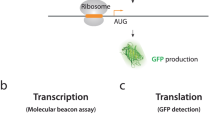Summary
Classical “antimutator” DNA polymerases of bacteriophage T4 were examined for their effects upon frameshift mutation rates at a number of positions within rII cistrons. Their antimutagenic activities reduced frameshift frequencies at a number of sites, but at other sites the opposite occurred: the mutant polymerases exhibited clear mutator activities. This dichotomy reveals the operation of two distinct mechanisms of frameshift mutagenesis that are correlated with the DNA sequences at the frameshift sites. Frameshift mutants subject to the antimutator effects of the mutant polymerase lie in A:T-run DNA sequences, where mutations presumably arise by means of the interstrand DNA misalignments postulated by classical theory. The frameshift mutants produced by the mutator activity of these same polymerases lie in quasipalindromic DNA sequences, where mutations are postulated to arise by aberrant metabolism of DNA secondary structures such as hairpins.
Similar content being viewed by others
References
Allen EF, Albrecht I, Drake JW (1970) Properties of bacteriophage T4 mutants defective in DNA polymerases. Genetics 65:187–200
Barnett L, Brenner S, Crick FHC, Shulman RG, Watts-Tobin RJ (1967) Phase-shift and other mutants in the first part of the rIIB cistron of bacteriophage T4. Phil Trans R Soc London, Ser B 252:487–560
Benzer S (1961) On the topography of the genetic fine structure. Proc Natl Acad Sci USA 47:403–415
Brutlag D, Kornberg A (1972) Enzymatic synthesis of deoxyribonucleic acid. XXXVI. A proofreading function for the 3′→5′ exonuclease activity in deoxyribonucleic acid polymerases. J Biol Chem 247:241–248
Crick FHC, Barnett L, Brenner S, Watts-Tobin RJ (1961) General nature of the genetic code for proteins. Nature 192:1227–1232
Drake JW (1963) Properties of ultraviolet-induced rII mutants of bacteriophage T4. J Mol Biol 6:268–283
Drake JW, Allen EF, Forsberg SA, Preparata RM, Greening EO (1969) The genetic control of mutation rates in bacteriophage T4. Nature (Lond) 221:1128–1132
Farabaugh PJ, Schmeissner U, Hofer M, Miller JH (1978) Genetic studies of the lac repressor. VII. On the molecular nature of spontaneous hotspots in the lacI gene of Escherichia coli. J Mol Biol 126:847–863
Gillin FD, Nossal NG (1976) Control of mutation frequency by bacteriophage T4 DNA polymerase. I. The CB120 antimutator DNA polymerase is defective in strand displacement. J Biol Chem 251:5219–5224
Huang C, Hearst JE (1980) Pauses at positions of secondary structure during in vitro replication of single-stranded fd bacteriophage DNA by T4 DNA polymerase. Anal Biochem 103:127–139
Ikoku AS, Hearst JE (1981) Identification of a structural hairpin in the filamentous chimeric phage M13Goril. J Mol Biol 151:245–259
Lo KY, Bessman MJ (1976) An antimutator deoxyribonucleic acid polymerase. I. Purification and properties of the enzyme. J Biol Chem 251:2475–2479
Muzycka N, Poland RL, Bessman MJ (1972) Studies on the biochemical basis of spontaneous mutation. I. A comparison of the deoxyribonucleic acid polymerases of mutator, antimutator, and wild type strains of bacteriophage T4. J Biol Chem 247:7116–7122
Okada Y, Streisinger G, Owen J, Newton J, Tsugita A, Inouye M (1972) Molecular basis of a mutational hot spot in the lysozyme gene of bacteriophage T4. Nature 236:338–341
Pribnow D, Sigurdson DC, Gold L, Singer BS, Brosius J, Dull TJ, Noller HF (1981) The rII cistrons of bacteriophage T4: DNA sequence around the intercistronic divide and positions of genetic landmarks. J Mol Biol 149:337–376
Ripley LS (1982a) Model for the participation of quasipalindromic DNA sequences in frameshift mutation. Proc Natl Acad Sci USA 79:4128–4132
Ripley LS (1982b) The infidelity of DNA polymerase. In: Lawrence CW, Prakash L, Sherman F (eds) Induced mutagenesis: Molecular mechanisms and their implications for environmental protection. Plenum, New York, pp. 85–116
Ripley LS, Shoemaker NB (1983) A major role for DNA polymerase in frameshift mutagenesis. Genetics 103:353–366
Streisinger G, Okada Y, Emrich J, Newton J, Tsugita A, Terzaghi E, Inouye M (1966) Frameshift mutations and the genetic code. Cold Spring Harbor Symp Quant Biol 31:77–84
Author information
Authors and Affiliations
Additional information
Communicated by Ch. Auerbach
Rights and permissions
About this article
Cite this article
Ripley, L.S., Glickman, B.W. & Shoemaker, N.B. Mutator versus antimutator activity of a T4 DNA polymerase mutant distinguishes two different frameshifting mechanisms. Molec Gen Genet 189, 113–117 (1983). https://doi.org/10.1007/BF00326062
Received:
Issue Date:
DOI: https://doi.org/10.1007/BF00326062




